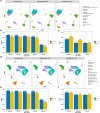ScInfeR: an efficient method for annotating cell types and sub-types in single-cell RNA-seq, ATAC-seq, and spatial omics
- PMID: 40471991
- PMCID: PMC12140018
- DOI: 10.1093/bib/bbaf253
ScInfeR: an efficient method for annotating cell types and sub-types in single-cell RNA-seq, ATAC-seq, and spatial omics
Erratum in
-
Correction to: ScInfeR: an efficient method for annotating cell types and sub-types in single-cell RNA-seq, ATAC-seq, and spatial omics.Brief Bioinform. 2025 May 1;26(3):bbaf337. doi: 10.1093/bib/bbaf337. Brief Bioinform. 2025. PMID: 40580031 Free PMC article. No abstract available.
Abstract
Cell-type annotation remains a major challenge in single-cell and spatial omics analysis. Most existing methods rely on single-cell RNA sequencing (scRNA-seq) references or predefined marker sets. However, the scarcity of high-quality scRNA-seq references and marker sets makes relying on a single approach prone to bias and limits usability. Furthermore, available methods for cell-type annotation in single-cell ATAC-sequencing (scATAC-seq) and spatial transcriptomics datasets perform poorly. Here, we present ScInfeR, a graph-based cell-type annotation method that combines information from both scRNA-seq references and marker sets. By integrating these two data sources, ScInfeR can accurately annotate broad range of cell-types. It employs a hierarchical framework inspired by message-passing layers in graph neural networks to accurately identify cell subtypes. ScInfeR is highly versatile, supporting cell annotation across scRNA-seq, scATAC-seq, and spatial omics datasets. For scATAC-seq, it effectively utilizes chromatin accessibility data, while for spatial transcriptomics, it incorporates spatial coordinate information. Additionally, ScInfeR supports weighted positive and negative markers, allowing users to define marker importance in cell-type classification. Our extensive benchmarking across multiple atlas-scale scRNA-seq, scATAC-seq, and spatial datasets, evaluating 10 existing tools in over 100 cell-type prediction tasks, demonstrated ScInfeR's superior performance. Noteworthy, it exhibits robustness against batch effects arising in these datasets. To facilitate seamless annotation, we developed ScInfeRDB, an interactive database containing manually curated scRNA-seq references and marker sets for 329 cell-types, covering 2497 gene markers in 28 tissue types from human and plant. ScInfeR is available as an R package, with both the tool and database publicly accessible at https://www.swainasish.in/scinfer.
Keywords: cell type annotation; scATAC-seq; scRNA-seq; spatial transcriptomics.
© The Author(s) 2025. Published by Oxford University Press.
Conflict of interest statement
The authors declare that they have no conflict of interest.
Figures






References
MeSH terms
Grants and funding
LinkOut - more resources
Full Text Sources

